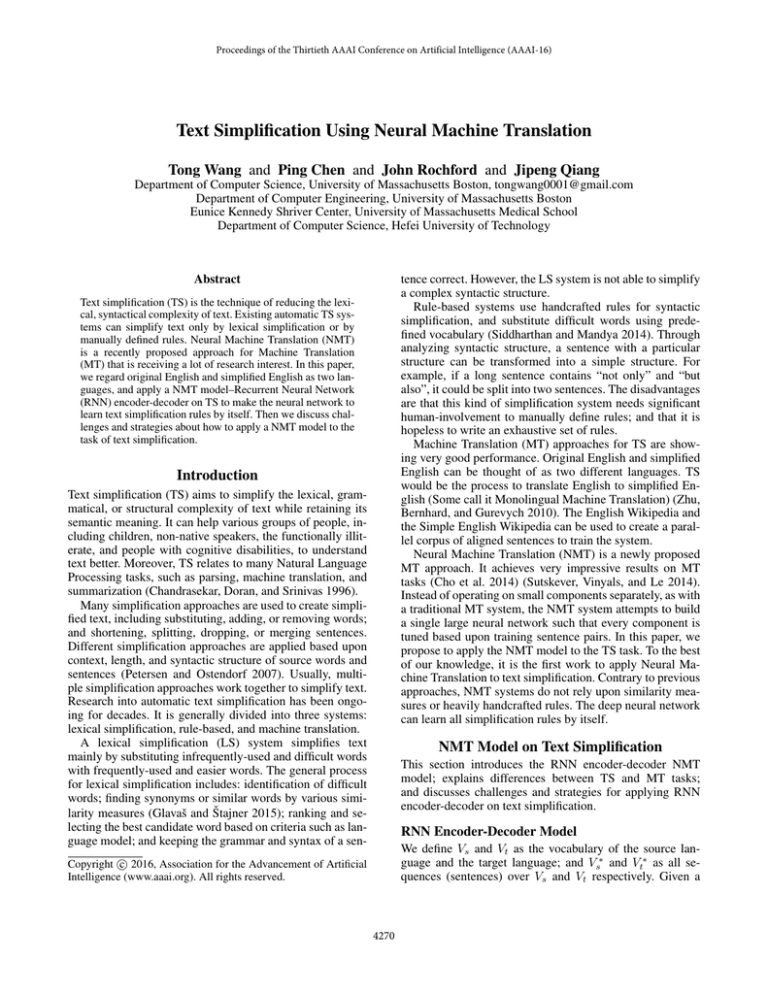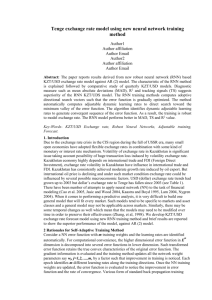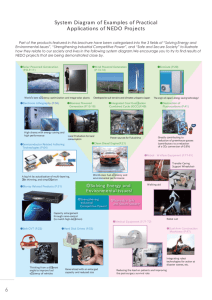
Proceedings of the Thirtieth AAAI Conference on Artificial Intelligence (AAAI-16)
Text Simplification Using Neural Machine Translation
Tong Wang and Ping Chen and John Rochford and Jipeng Qiang
Department of Computer Science, University of Massachusetts Boston, tongwang0001@gmail.com
Department of Computer Engineering, University of Massachusetts Boston
Eunice Kennedy Shriver Center, University of Massachusetts Medical School
Department of Computer Science, Hefei University of Technology
tence correct. However, the LS system is not able to simplify
a complex syntactic structure.
Rule-based systems use handcrafted rules for syntactic
simplification, and substitute difficult words using predefined vocabulary (Siddharthan and Mandya 2014). Through
analyzing syntactic structure, a sentence with a particular
structure can be transformed into a simple structure. For
example, if a long sentence contains “not only” and “but
also”, it could be split into two sentences. The disadvantages
are that this kind of simplification system needs significant
human-involvement to manually define rules; and that it is
hopeless to write an exhaustive set of rules.
Machine Translation (MT) approaches for TS are showing very good performance. Original English and simplified
English can be thought of as two different languages. TS
would be the process to translate English to simplified English (Some call it Monolingual Machine Translation) (Zhu,
Bernhard, and Gurevych 2010). The English Wikipedia and
the Simple English Wikipedia can be used to create a parallel corpus of aligned sentences to train the system.
Neural Machine Translation (NMT) is a newly proposed
MT approach. It achieves very impressive results on MT
tasks (Cho et al. 2014) (Sutskever, Vinyals, and Le 2014).
Instead of operating on small components separately, as with
a traditional MT system, the NMT system attempts to build
a single large neural network such that every component is
tuned based upon training sentence pairs. In this paper, we
propose to apply the NMT model to the TS task. To the best
of our knowledge, it is the first work to apply Neural Machine Translation to text simplification. Contrary to previous
approaches, NMT systems do not rely upon similarity measures or heavily handcrafted rules. The deep neural network
can learn all simplification rules by itself.
Abstract
Text simplification (TS) is the technique of reducing the lexical, syntactical complexity of text. Existing automatic TS systems can simplify text only by lexical simplification or by
manually defined rules. Neural Machine Translation (NMT)
is a recently proposed approach for Machine Translation
(MT) that is receiving a lot of research interest. In this paper,
we regard original English and simplified English as two languages, and apply a NMT model–Recurrent Neural Network
(RNN) encoder-decoder on TS to make the neural network to
learn text simplification rules by itself. Then we discuss challenges and strategies about how to apply a NMT model to the
task of text simplification.
Introduction
Text simplification (TS) aims to simplify the lexical, grammatical, or structural complexity of text while retaining its
semantic meaning. It can help various groups of people, including children, non-native speakers, the functionally illiterate, and people with cognitive disabilities, to understand
text better. Moreover, TS relates to many Natural Language
Processing tasks, such as parsing, machine translation, and
summarization (Chandrasekar, Doran, and Srinivas 1996).
Many simplification approaches are used to create simplified text, including substituting, adding, or removing words;
and shortening, splitting, dropping, or merging sentences.
Different simplification approaches are applied based upon
context, length, and syntactic structure of source words and
sentences (Petersen and Ostendorf 2007). Usually, multiple simplification approaches work together to simplify text.
Research into automatic text simplification has been ongoing for decades. It is generally divided into three systems:
lexical simplification, rule-based, and machine translation.
A lexical simplification (LS) system simplifies text
mainly by substituting infrequently-used and difficult words
with frequently-used and easier words. The general process
for lexical simplification includes: identification of difficult
words; finding synonyms or similar words by various similarity measures (Glavaš and Štajner 2015); ranking and selecting the best candidate word based on criteria such as language model; and keeping the grammar and syntax of a sen-
NMT Model on Text Simplification
This section introduces the RNN encoder-decoder NMT
model; explains differences between TS and MT tasks;
and discusses challenges and strategies for applying RNN
encoder-decoder on text simplification.
RNN Encoder-Decoder Model
We define Vs and Vt as the vocabulary of the source language and the target language; and Vs∗ and Vt∗ as all sequences (sentences) over Vs and Vt respectively. Given a
c 2016, Association for the Advancement of Artificial
Copyright Intelligence (www.aaai.org). All rights reserved.
4270
Machine Translation
Most frequent words (e.g.,
top 15,000) are used for
source and target languages.
Every
out-of-vocabulary
word is replaced with UNK
token.
|Vs | ≈ |Vt | and Vs ∩ Vt = ∅
Nearly no sharing words in
source sentence X and target sentence Y .
The relation between source
sentence and target sentence
is usually one to one.
directly. However, there are differences between the TS task
and the MT task, which we list in Table 1. Therefore, a single NMT model is not able to handle different text simplification operations. An option is to design a particular neural
network or other type of classifier to detect which operation(e.g., splitting, merging) should be applied first. Then,
we could design a different RNN encoder-decoder model to
simplify a specific simplification operation. For example, the
update gate and the forget gate of hidden units should memorize the long dependency for the merging operation of a
long input sentence. The hidden units should focus on the
short dependency for the splitting operation.
Text Simplfication
Infrequent words cannot be
simply ignored in the TS
task. It is important to simplify them.
|Vt | |Vs | and Vt ⊂ Vs
Some or even all words in
Y may remain the same after simplifying X.
The relation could be one to
many (splitting) or many to
one (merging).
Future Work
Table 1: Differences Between MT and TS task
This work is at an early stage. Due to the lack of available
aligned sentence pairs, the first step is to collect training
data. We plan to do so in two ways: crowdsourcing, or automatic discovery of aligned sentences from Simple English
Wikipedia and English Wikipedia. We will then train the
RNN encoder-decoder to score candidate words on a lexical simplification system. Our final goal is to build the RNN
encoder-decoder model to simplify any English sentence.
source sentence X = (x1 , x2 , ..., xl ), where X ∈ Vs∗ ,
xi ∈ Vs , and xi is the ith word in X, the target (simplified)
sentence is Y = (y1 , y2 , ..., yl ). l and l are the length of the
sentences. The length is not fixed. Our goal is to build a neural network to model the conditional probability p(Y |X),
then train the model to maximize the probability.
RNN is a class of Neural Network in which the connections between internal units may form a directed cycle to
exhibit the entire history of previous inputs. The structure
of RNN makes it an ideal model to process sequence inputs such as sentences with arbitrary lengths. RNN EncoderDecoder (Cho et al. 2014) (Sutskever, Vinyals, and Le 2014)
is a NMT model that can be jointly trained to maximize the
conditional probability of a target sequence given a source
sequence p(Y |X). It consists of two RNNs. One encodes
the source sentence into a fixed length vector. The other decodes the vector into a target sentence. We intend to apply
the RNN Encoder-Decoder model to the TS task.
To make RNN capture short-term and long-term dependencies of a sentence, the type of hidden units should
be carefully selected. The hidden units can be Long
Short-Term Memory (LSTM) (Hochreiter and Schmidhuber 1997) (Sutskever, Vinyals, and Le 2014) or other gating
units (Cho et al. 2014). The gating hidden units are crucial
for RNN to “understand” a sentence, since they are able to
carry out information from the previous hidden state, and
drop irrelevant information.
References
Chandrasekar, R.; Doran, C.; and Srinivas, B. 1996. Motivations and methods for text simplification. In Proceedings
of the 16th conference on Computational linguistics-Volume
2, 1041–1044. Association for Computational Linguistics.
Cho, K.; Van Merriënboer, B.; Gulcehre, C.; Bahdanau, D.;
Bougares, F.; Schwenk, H.; and Bengio, Y. 2014. Learning
phrase representations using rnn encoder-decoder for statistical machine translation. arXiv preprint arXiv:1406.1078.
Glavaš, G., and Štajner, S. 2015. Simplifying lexical simplification: Do we need simplified corpora? In Proceedings
of the 53th Annual Meeting of the Associatioin for Computational Linguistics (ACL-2015, Short Papers), 63.
Hochreiter, S., and Schmidhuber, J. 1997. Long short-term
memory. Neural computation 9(8):1735–1780.
Petersen, S. E., and Ostendorf, M. 2007. Text simplification
for language learners: a corpus analysis. In SLaTE, 69–72.
Citeseer.
Siddharthan, A., and Mandya, A. 2014. Hybrid text simplification using synchronous dependency grammars with handwritten and automatically harvested rules. In Proceedings of
the 14th Conference of the European Chapter of the Association for Computational Linguistics, 722–731.
Sutskever, I.; Vinyals, O.; and Le, Q. V. 2014. Sequence
to sequence learning with neural networks. In Advances in
neural information processing systems, 3104–3112.
Zhu, Z.; Bernhard, D.; and Gurevych, I. 2010. A monolingual tree-based translation model for sentence simplification. In Proceedings of the 23rd international conference
on computational linguistics, 1353–1361. Association for
Computational Linguistics.
Challenges and Strategies for Text Simplification
using RNN Encoder-Decoder
We may apply the RNN encoder-decoder model in two ways
for text simplification. We will use this model as part of
a LS system as an additional feature by scoring the candidate words of a source word. A LS system usually uses an
N-gram language model and information contents to score
candidate words. Theoretically, the NMT model is able to
strengthen the LS system to capture linguistic regularities
of whole sentences. Once the training of the RNN encoderdecoder is complete, we can produce the simplified sentence
by Ŷ = argmaxY p(Y |X). The candidate words will be selected accordingly to maximize the conditional probability.
We can use this model also to simplify English sentences
4271







